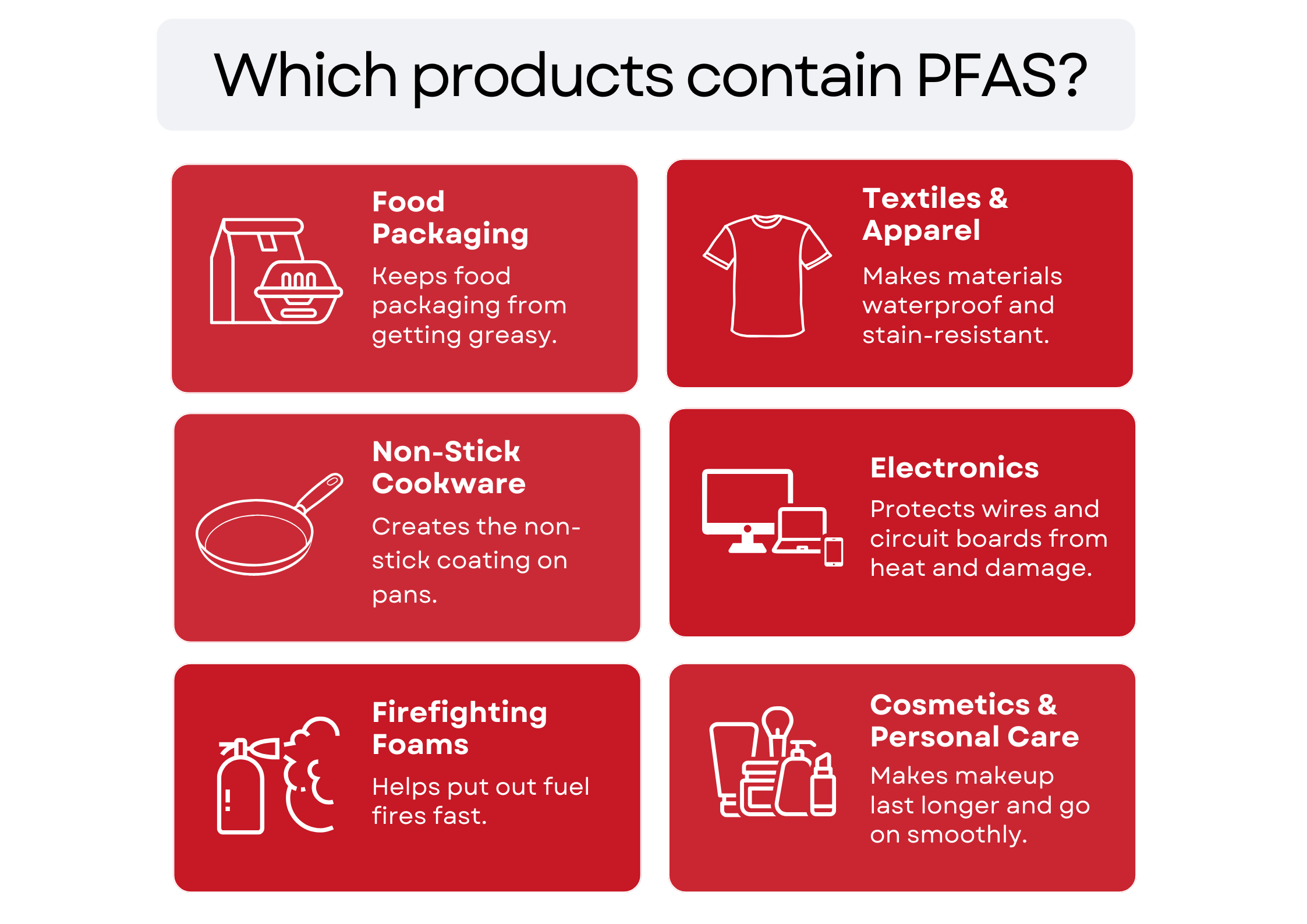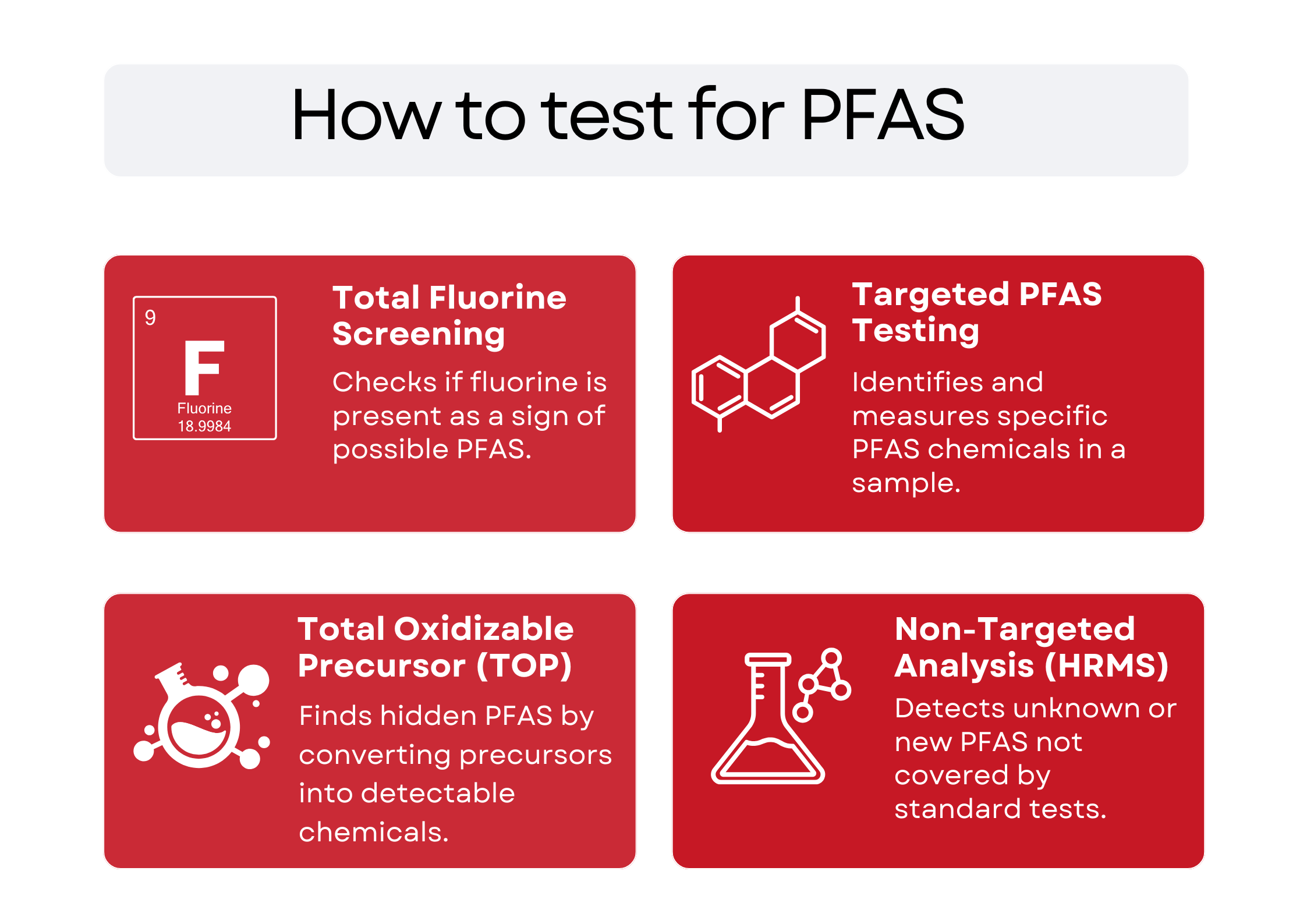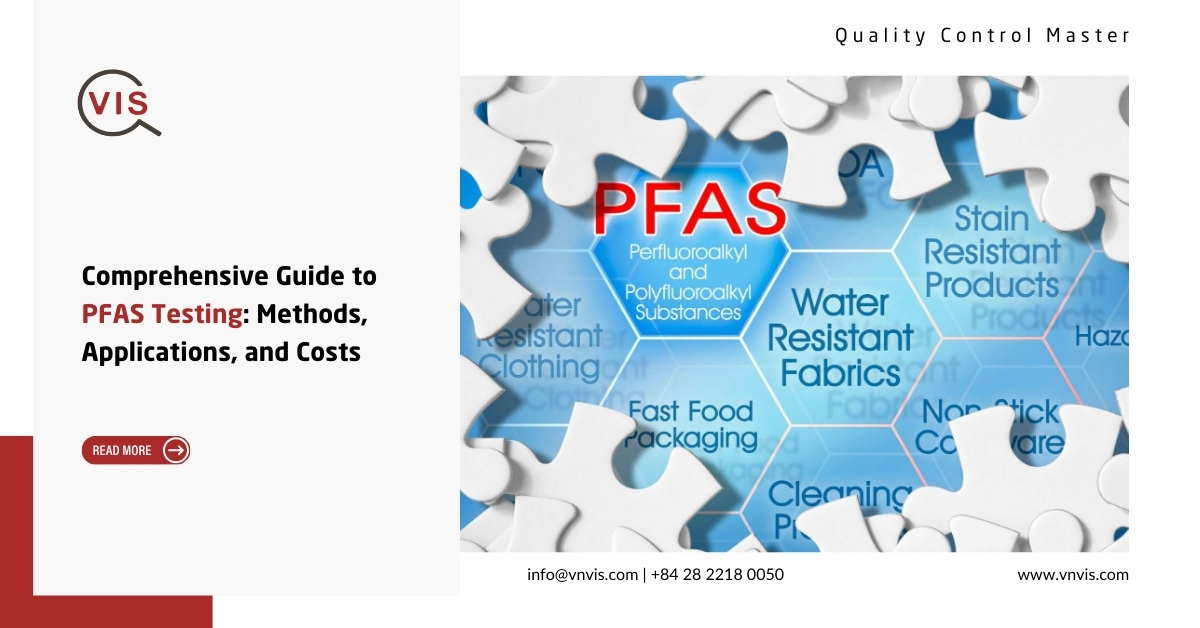What are PFAS?
PFAS (per- and polyfluoroalkyl substances) are synthetic chemicals widely used in consumer products such as non-stick cookware, waterproof apparel, food packaging, electronic components, and personal care products. Their resistance to heat, water, and oil makes them highly functional, but they have a significant drawback: they do not degrade easily.
Over time, PFAS can accumulate in water, air, soil, and living organisms, earning the designation “forever chemicals.” Their persistence in the environment, combined with the high cost and complexity of remediation, has raised concerns. Exposure to PFAS has been linked to serious health effects including cancer, immune system disruption, reproductive issues, hypertension, and thyroid disorders.
Due to these risks, global regulations concerning PFAS are becoming increasingly stringent.
Which products contain PFAS?

- Food Packaging: PFAS are used in grease-resistant wrappers, fast-food containers, and microwave popcorn bags to prevent oil and moisture absorption. These substances can leach into food due to their persistent nature.
- Textiles & Apparel: PFAS impart water and stain resistance to clothing, upholstery, carpets, and outdoor gear. While older formulations contained long-chain PFAS linked to health hazards, many brands are now transitioning to PFAS-free alternatives.
- Non-Stick Cookware: PTFE (Teflon) provides non-stick properties in cookware. Though PTFE is stable, older versions manufactured with PFOA, a type of PFAS, led to environmental contamination. PFOA has since been banned, but concerns about other PFAS remain.
- Điện tử: PFAS are used for thermal and chemical resistance in electronics, including insulation, circuit board protection, and semiconductor production. Their role is critical but poses regulatory challenges.
- Firefighting Foams: AFFF (aqueous film-forming foam), used for fuel fires at airports and military facilities, was effective but left long-lasting contamination in soil and groundwater.
- Cosmetics & Personal Care: Some long-wear makeup products, waterproof mascaras, and dental floss contain PFAS to improve texture and durability.
Total Fluorine Tests: A Rapid PFAS Screening Tool

Total fluorine (TF) and total organic fluorine (TOF) tests are screening methods used to detect the presence of fluorinated substances in samples. While they do not specify individual PFAS compounds, they provide a quick indication of whether fluorinated chemicals exceed a set threshold.
- PIGE (Particle-Induced Gamma Emission) is a non-destructive technique that analyzes the surface of materials like textiles and paper. It effectively detects fluorinated coatings but may overlook PFAS embedded within the material.
- Combustion Ion Chromatography (CIC) is a destructive method that incinerates the sample, converting fluorinated compounds to fluoride for quantification. It evaluates the full sample but cannot distinguish between PFAS and other fluorinated chemicals.
Though not definitive, total fluorine tests are widely used for preliminary PFAS screening, especially in food packaging and textiles. A common threshold is 100 ppm of fluorine—above this level, further PFAS-specific testing is often recommended.
Cost of Total Fluorine Testing
Total fluorine tests offer a cost-efficient initial assessment. PIGE and CIC typically range from a few hundred dollars per sample. Simpler alternatives like ion-selective electrodes (ISE) may reduce costs further. Many organizations opt for these screenings across large product batches, reserving detailed PFAS testing for samples that trigger concern.
Targeted PFAS Testing
When precise identification of PFAS compounds is required, targeted analysis is necessary. This involves detecting and quantifying specific PFAS using liquid chromatography-tandem mass spectrometry (LC-MS/MS).
Laboratories can test for 18 to over 100 PFAS compounds, depending on the method. Examples include:
- EPA Method 537.1 – Detects 18 PFAS in drinking water.
- EPA Method 533 – Covers 25 PFAS.
- EPA Method 1633 (draft) – Designed to detect ~40 PFAS in diverse matrices.
These tests are highly accurate but limited to known PFAS included in the analytical method, potentially missing lesser-known or newly developed compounds.
Cost of Targeted PFAS Testing
Targeted PFAS testing is more expensive than screening. LC-MS/MS testing typically costs between $400–$700 per sample, depending on the number of compounds and matrix complexity.
Advanced PFAS Testing Methods
For detecting unknown or precursor PFAS compounds, advanced testing techniques are available:
- TOP Assay (Total Oxidizable Precursor Assay): Converts precursor compounds into detectable PFAS like PFOA through oxidation. It is particularly useful for complex samples such as firefighting foam and wastewater.
- Non-Targeted Analysis (High-Resolution Mass Spectrometry): LC-QTOF-MS enables broad-spectrum detection of fluorinated substances, including unknown or emerging PFAS. This is primarily used in research due to high cost and complexity.
PFAS Testing in Food, Products, and Water
- Đồ ăn: PFAS testing in food measures 16 specific compounds using extraction and cleanup steps tailored to food types (e.g., meat, eggs). Detection limits can reach parts-per-trillion (ppt) levels. Isotope-labeled standards are employed for high accuracy.
- Food Packaging: Certified laboratories often begin with a total fluorine test.
- TOF < 100 ppm suggests no intentional PFAS use.
- TOF > 100 ppm warrants further targeted analysis to confirm and identify PFAS.
- Consumer Products: Items like textiles, plastics, and electronics undergo a two-step testing approach—initial screening via PIGE or CIC, followed by LC-MS/MS for specific PFAS detection. Advanced tests such as TOP Assay or non-targeted HRMS may be employed if contamination is suspected but not confirmed.
- Water: PFAS contamination in water sources can arise from industrial discharge, AFFF use, and leaching from landfills.
- LC-MS/MS is the gold standard for detecting trace PFAS in drinking water.
- Preliminary screening with total fluorine tests may precede detailed analysis.
- For complex matrices like wastewater, advanced techniques such as the TOP assay or HRMS are often necessary to identify precursor or hidden PFAS.
These testing strategies help manufacturers, regulators, and environmental stakeholders monitor PFAS contamination and meet evolving safety standards.




Bài viết liên quan